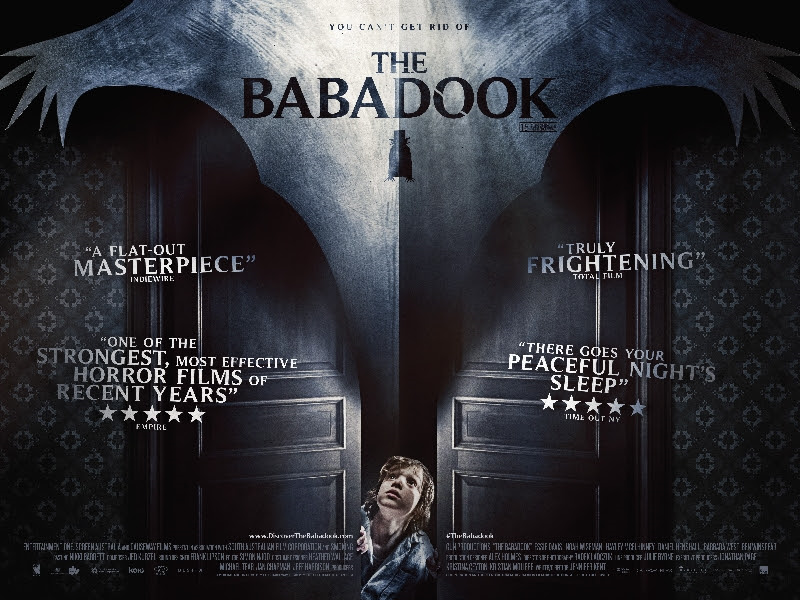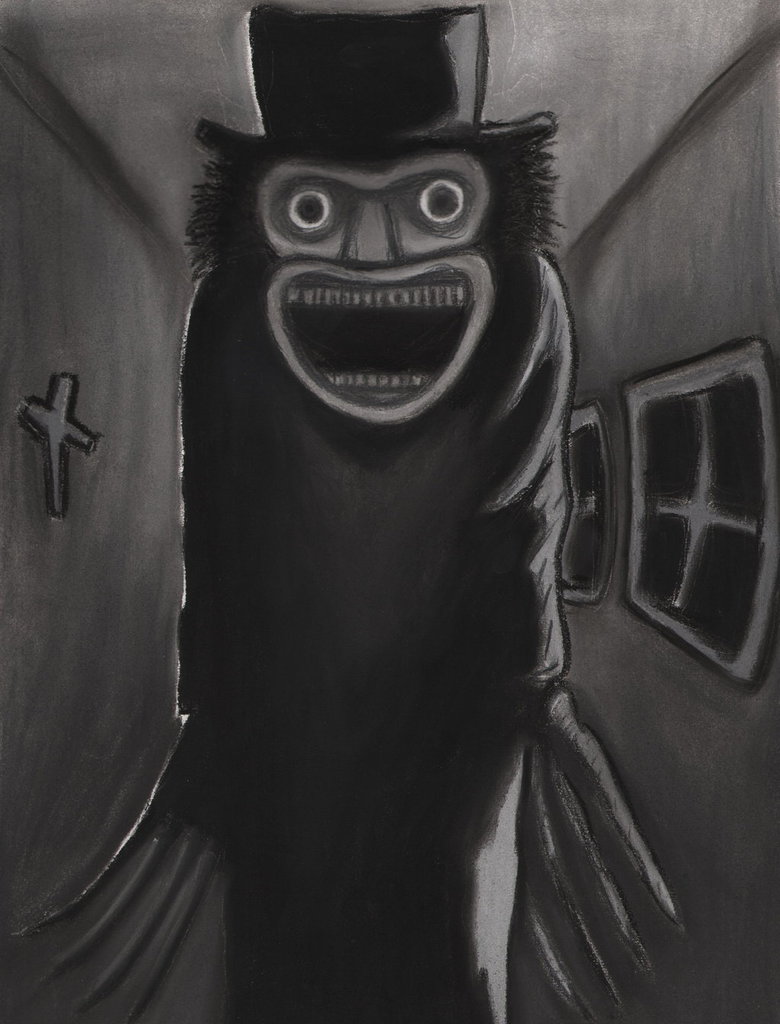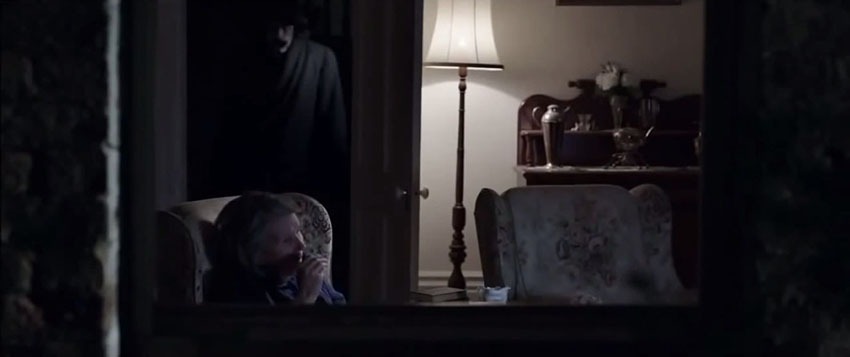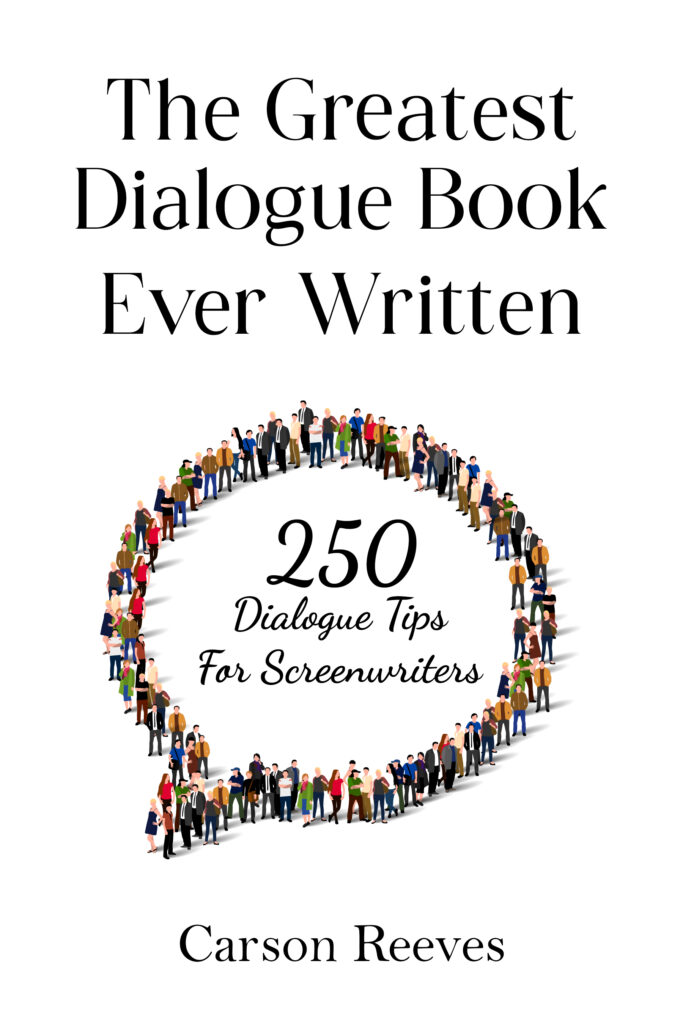Search Results for: scriptshadow 250
The Scriptshadow Newsletter, featuring a review of one of the latest spec sales AND news about The Scriptshadow 250, has been SENT. If you did not receive the newsletter, check your SPAM and your PROMOTIONS folders to make sure it isn’t there.
Genre: Horror
Premise: A single mother starts to turn against her developmentally challenged young son when he insists that he’s being visited by a mythical fairy tale creature named “The Babadook.”
About: The Babadook first took the movie-going world by storm during a midnight screening at Sundance, where it instantly broke through and became a buzz-worthy hit. Originally released in Australia, it’s just now coming to the U.S., where it’s in limited release and available on Itunes. Inspired by filmmakers such as David Lynch and Lars Von Trier (whom she worked for once), writer-director Jennifer Kent went into her first directing experience terrified but confident. She felt that if the offbeat and unorthodox Von Trier could direct a film, that she could probably pull one off herself. Of course, she had to make SOME concessions. She originally wanted to shoot the movie in black and white, but was talked out of it by her understandably wary producer.
Writer: Jennifer Kent
Details: 93 minutes
One thing becomes clear as you start watching The Babadook: It’s different. There’s a subdued understated quality to the filmmaking that’s mildly off-putting. I don’t know how to describe it other than to say it’s “lonely.”
Sometimes that works for the movie and sometimes it doesn’t. Because The Babadook really is its own thing. A contained thriller almost, it locks you into this house with a mother and son and keeps you there against your will. For that reason, the film always feels a little claustrophobic. Normally that would be a good thing for a horror film. But is this a horror film?
Some could argue that The Babadook is more of a drama than anything. And Kent seems to support this take when she says she never overtly tried to create a scare in the movie (although I might argue that point with the terrifying Amelia-hiding-under-the-covers “Baaaaa-baaaaaa-doooooook” moment).
But while the movie struck a chord in me in a way that the “Ouijas” of the world could never accomplish, I’m still not sure how I feel about Baba. Maybe expectations have crippled my ability to see the film objectively. I wanted to be scared but instead I was kind of tricked into watching a troubled mother-son story. But isn’t that what all good movies do? Lure you in with the hook then keep you there with the characters? Uggghhhh, my mind says yes but my horror-loving heart says that wasn’t enough!
The Babadook is a simple story. Amelia is a single mother trying her hardest to raise her 6 year old son, Samuel. Samuel’s kind of a troubled kid. He’s prone to bouts of screaming and delusions, making the already difficult task of raising a child THAT much more difficult.
Well, it’s about to get even more difficult. Amelia starts catching Samuel in his room talking to someone, except there’s no one there. When she asks him about it, Samuel says he’s talking to the “Babadook,” the spooky imaginary character from one of his children’s pop-up books.
We eventually learn that the reason there’s no father in this picture is because he died when their car crashed while racing to the hospital during Amelia’s labor. Samuel’s birth literally killed his father, and there’s some deep buried resentment from Amelia because of it.
As Samuel becomes more and more insistent that Mr. Babadook is real, Amelia finally starts to crack, and all those extra hours taking care of her troubled child turn her into a monster hell-bent on killing her son. Thus the question arises. Who’s the real Babadook? The man in the book or Amelia herself?
What’s that old saying? “Be careful what you wish for?” Not long ago after watching Doll Shit – I mean, Annabelle – I complained that horror movies were getting too light. Writers weren’t delving into their characters and those characters’ psyches and finding those evil nooks and crannies that bring true horror to life.
Well, that’s exactly what The Babadook is. It’s a heart-wrenching EXTREMELY intense look at a fractured and complicated mother-son relationship, one where the mother starts to lose it, and becomes convinced that her child must pay the ultimate price. But if this is what I wanted, why don’t I feel satisfied?
I mean this IS what memorable horror movies do. They’re so realistic that you’re afraid they could actually happen. Look at The Exorcist and how realistically that whole situation was portrayed. You didn’t get characters opening bathroom mirrors to look for toothpaste, then closing them, only to see a skeleton face behind them in the reflection. You got those terrifying trips to the hospital with shock therapy, where a mother watched helplessly from outside the room as her daughter was tortured.
That’s the same way The Babadook approached its horror.
And yet… and yet… it felt TOO raw. TOO intense. There’s a scene late in the movie where the mom is so hell-bent on killing her kid that I thought to myself, “This isn’t a horror movie any more. This is just a fucked up mom who wants to kill her child.” It was… disturbing.
With that said, The Babadook is still a film worth seeing because it does something so few horror movies actually do. It dares to be different. As Kent says in one of her interviews, she had no interest in creating any jump scares. This is a movie where the horror gets under your skin and lives inside of you. Maybe that’s why it’s troubling me so much.
But yeah, I mean, look at the way Kent dealt with the story’s monster, which I thought was really clever. We never get a completely clear look at the Babadook, but from what we do see, it’s got this paper-mache design to it, as if it’s being plucked right out of the pop-up Mister Babadook book. How often do we get a unique monster in a horror script? Not often.
Another thing I noticed here was that this was a female writer. You could really tell that. And I don’t say that in a good way or a bad way, but a way in which you could tell this was a different point of view from what we’re used to seeing in horror, where the scares are less foreplay and more “straight to the deed.”
Kent inhabited her lead female character in ways I just don’t see men do. I mean, I see good male writers inhabiting their male characters. But The Babadook was a great reminder that the female characters need just as much of your infatuation as the male ones. You can never BE female if you’re a male. But you can do your best to ask yourself, “What would a woman do in this situation?” “What would a woman think in this situation?” You need this approach if you’re going to add even a fraction of authenticity to your female characters.
Lastly, I just wanted to say that it’s okay to include things in your horror script that people have seen before. For example, The Babadook is built on the age-old conceit of the child who talks to an invisible person. How many times have we seen that before? But it’s okay as long as you’re making a concerted effort to actively avoid cliché in as many other of your choices as possible. The core of this story is an intense honest unique relationship between mother and son that we haven’t seen before in a horror film. And since that’s such a dominant part of the script, we don’t see the “kid sees invisible people” moment as cliché. We only see that sort of thing as cliché when all the rest of your choices are cliche.
[ ] what the hell did I just watch?
[ ] wasn’t for me
[x] worth the price of admission
[ ] impressive
[ ] genius
What I learned: One of the ways to make your script stand out – and horror is a great place to do this – is to tackle taboo or dangerous subject matter. A big reason The Babadook has risen above all these other lame wanna-be-horror movies, is that it presents a truly terrifying situation – a mother who wants to hurt her child. That’s not a comfortable or safe situation to document in a story. Which is why this movie hits the viewer so hard.
What I learned 2: Make sure the creature in your horror film is born out organically from the story. This will ensure that you create something unique. Too many writers only care about creating a cool scary-looking monster. Instead, figure out where your creature is from, and build the monster from there. So if it’s from underground, it might be draped in weeds. If it’s from a giant farm, it might have an Scarecrow-like appearance. In this case, the monster came from a pop-up book, so it had a pop-up paper mache look to it.
SINCE I HAVE NO IDEA IF THE NEWSLETTER IS GETTING TO PEOPLE, I’M JUST GOING TO INCLUDE IT HERE ON THE SITE. ENJOY! AND IF YOU WANT FUTURE NEWSLETTERS, E-MAIL ME AT CARSONREEVES1@GMAIL.COM. THAT’S ASSUMING I CAN GET THEM SENT OUT!

I was talking to an aspiring writer the other day and we got onto the topic of movies, specifically what we’d seen lately. He said that he’d rewatched this old movie that both of us liked and I said to him, “Have you ever read the script for that movie? It’s even better than the film.” What he said next shocked me. “I don’t read scripts.”
I gasped and replied, “What do you mean, you don’t read scripts? Like you don’t read them that often?” He said, no, he’d read maybe three scripts in his entire life and they were all classic film scripts. “You’ve never read a screenplay that hasn’t become a movie yet??” I asked. “No,” he said. “Never.”
This wasn’t the first time I’d heard this from a writer. In fact, I once knew a writer who didn’t just *not read* scripts, he was so uninterested in doing so, he’d go on 20-minute villain monologues about how pointless (and boring) reading scripts was. And he had proof to back it up! He actually sold a screenplay! For mid-to-six figures!

How the heck did that happen? Well, to his credit, he was really good at picking high concepts and injecting GSU (goal, stakes, urgency).
But there was always something off about his writing that I couldn’t put my finger on. The rhythm wasn’t quite there. The sentence structure was slightly odd. And just the whole experience of reading his scripts felt like you were reading a “highlights reel” of a script, ” if that makes sense. His scripts never felt like true screenplays.
Not that I wish any ill will on writers, but I wasn’t surprised to hear that the writer hung it up three years later, failing to experience any more success. You can sometimes get a lucky invite into the game. But it’s hard to stay if you don’t know what you’re doing. People figure that out sooner or later.
I have no doubt that the fact this writer had never read any screenplays before hurt his writing A LOT. Let me explain why.
I’m currently working with an actress who’s writing her first screenplay. It’s a true story about the birth of a particular tech industry. One of the issues she’s running up against is explaining the complicated world of that industry which is clear to her but foreign to us. So I sent her the Sam Bankman-Fried script I reviewed the other day, which did a lousy job of explaining its industry, in order to show her how the lack of properly conveyed exposition makes it hard for a reader to follow along.
It’s only when you experience writing weakness as a reader that it clicks for you what you have to demonstrate in your own scripts. How can you possibly understand how to keep someone interested in your story if you have never read a screenplay that’s kept your interest before? How can you ever understand how to keep someone from getting bored if you yourself have never been bored reading a screenplay before? How can you understand the rhythm of a screenplay if you’ve never been subjected to good screenplay rhythm? How can you know how much information the reader needs about your world if you’ve never read a script that effortlessly disseminates a lot of information?
You can’t just answer, “I can do that because I watch movies” because you’re not yet writing for a movie audience. You are writing for a reader. A series of readers must approve of your script before it can become a movie. So you have to be hip to THAT PERSON’S EXPERIENCE, not the audience member’s experience. And believe me, it’s a different ballgame. Movies are a passive experience. Reading is an ACTIVE experience. Or, to put it bluntly: Reading is harder than watching. So the bar for keeping the person engaged is higher.
I’m not saying you need to read as many scripts as I do. But you need to read at least a couple of scripts a month. Lucky for you, I have some reading material to pass on! I’m giving you four good scripts and two bad ones. You may be wondering why I’m including bad scripts. It’s because you need to know what types of things frustrate readers. You can’t write a good script unless you’ve been on the receiving end of a bad one. Because those are the scripts that drill into your head, “I’m going to make sure I never do that myself.”
Here are the scripts. Start your reading TODAY.
GOOD EXAMPLE #1
Title: After The Hunt
Logline: A Yale professor up for tenure must navigate a rape accusation from her most cherished student against another professor, who happens to be her best friend at the school.
Why I included it: This is considered to be the best script of the year so it’s definitely one you’ll want to check out.
GOOD EXAMPLE #2
Title: The Nowhere Game
Logline: Two young women are kidnapped, brought deep into the woods, given a head start, and then hunted down by their sadistic captor all for the pleasure of the online fans of “The Nowhere Game.”
Why I included it: This is a great example of how to write a script that reads quickly. Those tend to do well with readers because readers don’t have a lot of time.
GOOD EXAMPLE #3
Title: Dying for You
Logline: A low-level worker on a spaceship run by a dark god must steal the most powerful weapon in the universe to save his workplace crush.
Why I included it: This is one of my favorite scripts from last year. It’s really fun and effortless to read.
GOOD EXAMPLE #4
Title: Anaconda
Logline: A group of 40-something friends decide to remake their favorite film, Anaconda, in the real Amazon forest, only to learn that an actual giant Anaconda snake is out there.
Why I included it: I don’t love this script. But it’s a great example of how to come up with a fresh angle on an old property that the studios might get excited about if you pitched it to them. This film is being made with Paul Rudd and Jack Black. (More details on this project later)
BAD EXAMPLE #1
Title: Return to Sender
Logline: A woman who’s moved into a new home and is buying a lot of things from a giant delivery company learns that she is being used for a new delivery scam.
Why I included it: This script only got recognition because the writer directed a short that did okay. But the feature adaptation of that short is awful. Note how boring it is. Note how the story barely moves. Note how small the story feels. It’s an exercise in how easy it is to make it nearly impossible for the reader to turn the pages.
BAD EXAMPLE #2
Title: Star Blazers
Logline: A rag-tag group of space pirates come together to travel to a mysterious planet to retrieve a technology that will help them defeat the alien presence that has annihilated earth.
Why I included it: This is an old script that Hollywood never made. You can see that there’s not a single original idea in the script. It also takes waaaaay too long for the main plot to get started, a COMMON problem I see in screenplays, especially for newer scriptwriters.
It’s fine if you dislike any of the scripts I recommended here or like the ones I didn’t. The objective isn’t to have you mirror my taste. It’s to help you develop your own. Regardless of which side of the fence you end up on, take note of *WHY* you like something or *WHY* you don’t. That way, you can apply (or not apply) that same approach to your own material.
NOW TAKING SUBMISSIONS FOR “SEPTEMBER SCENE SHOWDOWN!”
This month’s showdown is a SCENE SHOWDOWN. I enjoyed the process of posting the first five pages of the Mega-Showdown finalists. So I thought I’d capitalize on that theme this month. Hence, we’re going to have a SCENE SHOWDOWN. Your scenes can be five full pages long and not a word more. Write the best scene possible, submit it to me, and I will post the best five entries on the site. Another reason I’m doing this is so as many of you can enter as possible. You can write a scene in a single day. So take advantage of this. Help me discover a writer who’s ready to blow up!
For the submission, it’s going to be a little tricky, cause it’s hard to write a title or a logline for a single scene. But the good news is, I’m going to read every scene that’s submitted. And I’ll be choosing on strength-of-scene rather than the title or logline. So do your best. Also, I’m going to give everyone 30 words to prep the scene if they want to. So, here are the submission details:
Title
Genre
Logline
Up to 30 words to prep the scene
PDF of scene (up to 5 pages long)
Send to: carsonreeves3@gmail.com
Deadline for entries is 10pm Pacific Time, Thursday September 26th!
AROUND TOWN

Mega-Showdown Winner, “Bedford” – The Scriptshadow Mega-Showdown winning script won me over just as it did the readers. It is a taut contained thriller in the vein of The Vast of Night. But it stirred quite a bit of controversy in the comments, with a lot of readers claiming it’s more of a stage-play than a film, since the majority of it takes place in one room and focuses on a single character. If the script were to be filmed, they argued, it would be boring because there’s nothing cinematic about it. It’s the age-old dilemma every aspiring screenwriter faces. The best way to get the most interest is to write something contained and low-budget. However, by doing so, you risk writing something static and boring. I, personally, think you could make a cool movie out of Bedford. Keep the camera moving when possible. Maybe get the hero out of the control tower a couple of times so that the location doesn’t get too stale. It was fun to see all the responses to the script. We haven’t had that spirited of a discussion about a screenplay in a long time. You can read the script for yourself here then head over and read my review!
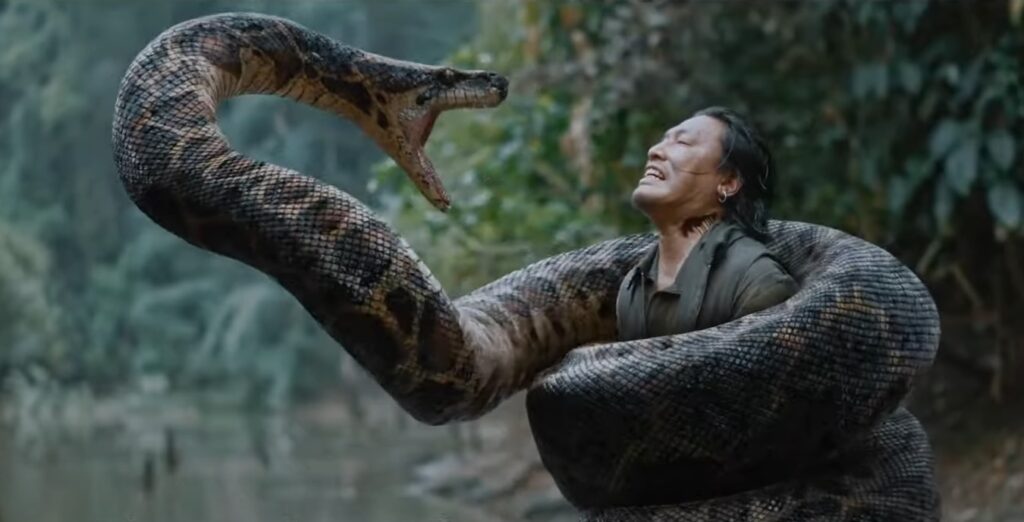 Weird Anaconda Reimagining Somehow Going Forward at Sony – When I read this Anaconda reboot script, I thought it was a fun experiment but, by no means did I think they were going to make it. It was too weird – like something a couple of stoner college kids would write in between parties on Spring Break. But guess what? Sony’s actually going through with it! They’re signing Jack Black and Paul Rudd to play the leads, which certainly makes the project more enticing. For those who don’t know, the new Anaconda movie is going to follow a group of former aspiring filmmakers who loved the original Anaconda so much, they head to the jungle to film a low-budget version of the film in the hopes of selling it to Sony. Except they quickly learn that the giant anaconda snake is real! And it’s after them! Sony is obviously trying to do what they did with the Jumanji franchise. They took a sort-of popular movie from the past and reimagined it as a video game. So there’s some logic to the offbeat approach. But I’m just telling you – the script was really sloppy. It literally feels like the characters are making things up as they go along. If this movie is going to work, they will need to massively tighten up the story. Cause it’s a loosey-goosey premise as it is. When you add a casual narrative to a loosey-goosey premise, it has the potential to become a “What the fuck did I just watch” movie.
Weird Anaconda Reimagining Somehow Going Forward at Sony – When I read this Anaconda reboot script, I thought it was a fun experiment but, by no means did I think they were going to make it. It was too weird – like something a couple of stoner college kids would write in between parties on Spring Break. But guess what? Sony’s actually going through with it! They’re signing Jack Black and Paul Rudd to play the leads, which certainly makes the project more enticing. For those who don’t know, the new Anaconda movie is going to follow a group of former aspiring filmmakers who loved the original Anaconda so much, they head to the jungle to film a low-budget version of the film in the hopes of selling it to Sony. Except they quickly learn that the giant anaconda snake is real! And it’s after them! Sony is obviously trying to do what they did with the Jumanji franchise. They took a sort-of popular movie from the past and reimagined it as a video game. So there’s some logic to the offbeat approach. But I’m just telling you – the script was really sloppy. It literally feels like the characters are making things up as they go along. If this movie is going to work, they will need to massively tighten up the story. Cause it’s a loosey-goosey premise as it is. When you add a casual narrative to a loosey-goosey premise, it has the potential to become a “What the fuck did I just watch” movie.
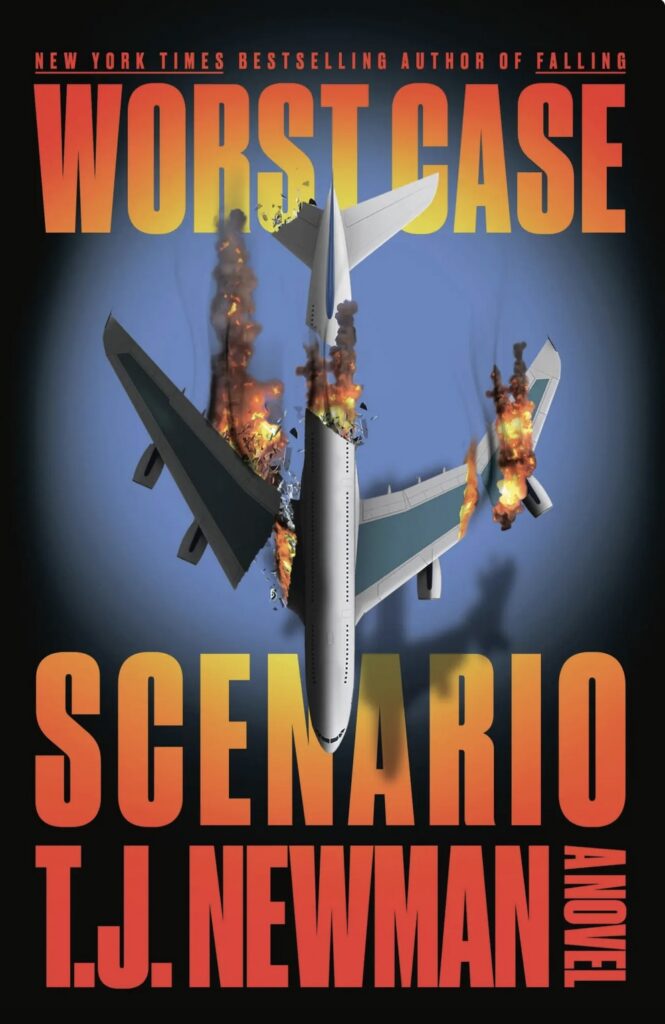
Worst Case Scenario – TJ Newman is back with her third big thriller book. For those who don’t know Newman’s journey, she’s the flight attendant who wrote a book in between serving passengers on transatlantic flights. She then sent her first book, Falling, to 40+ agents, all of whom rejected her. Until finally she landed one, which helped her secure a million dollar movie deal for the book. What I like about TJ is that she writes these high concept ideas as fast-moving thrillers. In that way, they mimic screenplays. This allows for quick and dirty reads that present the core concept in a digestible way. In other words, they’re easy for a producer to say ‘yes’ to. Newman said this idea – a plane crashing into a nuclear reactor – came to her because, in a search for story ideas, she asked all the pilots she knew what their biggest fear was. One of them said, that a terrorist not only hijacked their flight, but flew the plane into a nuclear reactor. Pro tip: Be ready for success like TJ Newman was. She wrote her second novel QUICKLY and, therefore, was able to take advantage of the buzz surrounding her first sale, grabbing a second flashy movie deal with “Drowning.” And she wrote this third book pretty fast as well. If you wait too long and a movie falls apart before production or the movie gets made and it sucks, you lose all that buzz, which makes it much harder to sell stuff. But if you can write more books and scripts BEFORE any of that happens, you can really cash in. That’s what Newman did.

Jurassic World Rebirth – Things have gotten so competitive in the content space that studios aren’t even waiting the minimum amount of time to reboot franchises anymore (that would be 5 years). They’re now trying to do it in 3 years! The last Jurassic World movie came out in 2022. This new one, starring Scarlett Johanssen, will come out in 2025 (funny enough, the setting for the new story will take place 5 years after the previous film). Here’s the premise: The three biggest dinosaurs have a genetic secret that will help save a bunch of human lives. So Scarlett must travel across the world and get DNA samples from these three rogue dinosaurs. But, in the process, she gets stuck on an island with them. Let’s be honest – it’s an uninspired, borderline clumsy, premise. You would think that if they were rushing to get this made, they’d have something sexier. But this feels like par for the course. It is interesting to note how Anaconda is rebooting itself in a risky way whereas Jurassic World is taking zero creative risks. There is a mystery as to what is on the island in this movie. It could be the long-rumored “Dino-humans” that found their way into earlier Jurassic Park sequel drafts. But I don’t think Dino-humans are going to cut it for audiences. This feels like a cash-grab and the stench of that greed is so thick, I’m anticipating nobody showing up for dinner.
Don’t Forget to Grab The Greatest Dialogue Book Ever Written!
This Labor Day, it’s time to finally improve your dialogue. I keep running into amateur scripts with weak or average dialogue. My dialogue book gives you specific instructions on how to add more flavor to your characters’ interactions. It’s just $9.99 and has over 250 dialogue tips in it. That’s 240 more than anybody else is going to give you. What are you waiting for!?
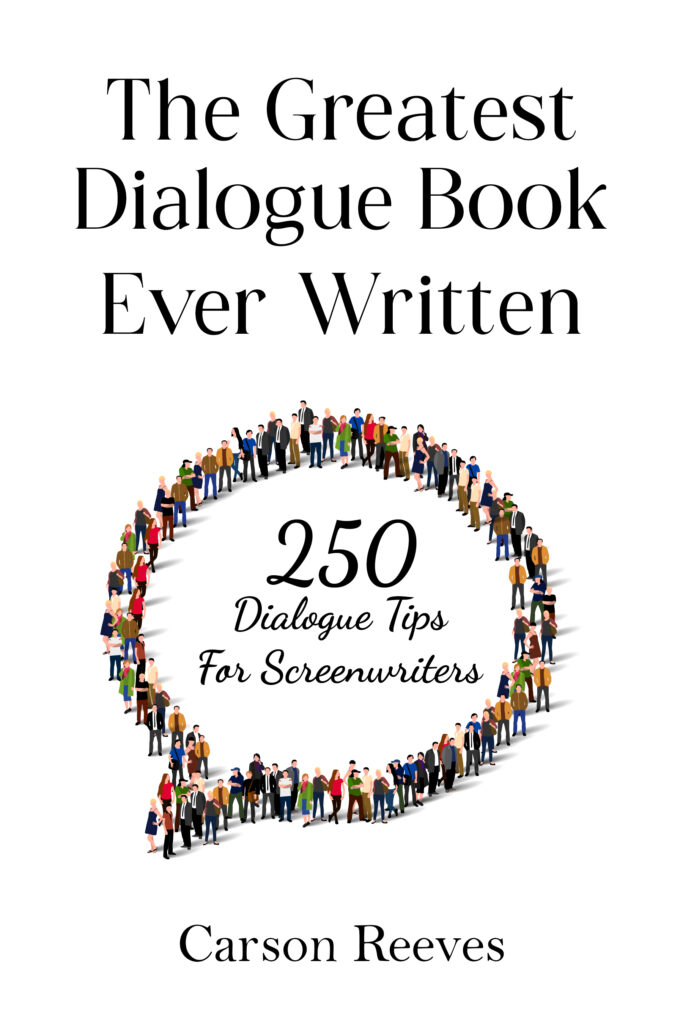
Book Review – Caught Stealing
Genre: Crime/Thriller
Premise: A baseball-loving lowlife agrees to cat-sit for his neighbor, inadvertently getting pulled into the seedy underworld of New York crime, where people will do anything to get the money they deserve.
About: This is uber-auteur Darren Aaronfsky’s (The Whale, Requiem for a Dream) latest project. It has a flashy cast list that includes “Elvis,” wannabe Oscar-winner Austin Butler, House of The Dragon’s Matt Smith, and borderline Hollywood royalty, Liev Schrieber. The writer, Charlie Huston, has written six books and tons of comics.
Writer: Charlie Huston
Details: about 250 pages

It’s always interesting to see which projects great directors, actors, and producers choose, as it’s a window into their decision-making process and, therefore, knowledge you can use if you ever get an opportunity to pitch them yourself.
But, with this one, there isn’t a lot of guesswork as to why Aronofsky chose it. His previous movie was all about a man glued to his chair (The Whale). This movie is all about a man who never stops moving. Whether Aronofsky was conscious of that radical shift or not, he obviously wanted to go in the opposite direction of “guy on chair.”
New York City. Hank is a professional drunk. He used to have a future as a major baseball prospect but nowadays, in his 30s, his only proximity to baseball is betting on it. After a particularly gnarly night of drinking, Hank is asked by his apartment neighbor, Russ, to take care of his cat while he’s gone. Hank thinks nothing of it and agrees.
The next day, after he feeds the cat, he moves the cat litter box and finds a key taped to the bottom of it. Hank shrugs and heads out to drink again. When he gets back, some Russian guys want to talk to him. They explain that they’re looking for his neighbor, Russ, and they really REALLY need to find him. Hank tells them the truth – he doesn’t know where his neighbor is or when he’ll be back – and they begrudgingly leave.
But the next day, the Russians come back, and this time they’re a lot less kind. They know Hank knows where Russ is as well as where the key is. Then they beat him up badly to let him know how much they need that key. Hank says fuck this and calls the cops. A policeman named Roman comes over. Asks him a bunch of questions. Roman says be more careful. And leaves.
The day after that, two large black men in cowboy attire show up and THEY want to know where the key is. They drive him around and rough him up in order to let him know how much they need that key. As soon as they’re gone, the Russians come back to beat Hank up some more. But this time, they bring Roman with them. Yes, Roman the Cop is working with the Russians.
Fun and games are over. If Hank doesn’t give them the key, they’re going to kill him. Okay fine, Hank says. I’ll get you the key. There’s only one problem – Hank hid the key when he was blackout drunk. So he doesn’t remember where it is. His best guess is at the bar he always hangs out at. But telling Roman that is a big mistake. They all head there and Roman’s men mow down everyone at the bar when they don’t offer up access to the key. This makes Hank the most wanted man in New York.
Just when things can’t get any weirder, Russ returns, finally providing clarity to the key’s importance. That key is for a storage unit that contains 4.5 million dollars. Hank will have to figure out how to push Russ out of this equation, get the money back to the bad guys so they’ll leave him alone, and oh yeah, get the cat back from Roman. Spoiler alert. IT’S NOT GOING TO BE EASY!
The one thing I’ll give Caught Stealing is that, once you read it, it’s impossible to get it out of your head.
It’s one of the most raw, visceral, intense, violent, things I’ve ever read. And it isn’t just the 50,000 punches thrown that you feel. It’s the limitless amount of alcohol being poured down our hero’s throat. It’s the devil-like screaming at Hank from every character he encounters. Even the anguish in this book feels like physical punishment.
But the story has a pretty glaring weakness. And while I believe that Aronofsky is the director best suited to tackle this weakness, I’m not convinced he can overcome it. That weakness is that the story is led by one of the most passive characters I’ve ever come across.
60% of this story is Henry getting his ass handed to him. He’s a punching bag. Again. And again. And again. And again. And again.
I suspect that’s the point. There’s some sado-masochist thing going on with Aronofsky where he wants to show someone get relentlessly beat up for 2 hours. I just don’t know if audiences are going to be able to handle it. Cause it’s so uncomfortably relentless!
But the passivity really bothered me. I’m trying to think of movies that have attempted this before. There was Equalizer 3. Denzel’s character sat back and waited most of the movie. But that was a unique situation in that we knew, from his two previous films, what he was capable of and that it was only a matter of time before he beat some ass.
And then there was Fury Road, where Mad Max gets thrown on the front of a truck for the first 45 minutes and doesn’t do anything. But he eventually got out and began kicking ass.
While it’s true that, once the midpoint hits, Hank starts becoming more active, I’m not sure it made up for the first half of the movie where the dude was just thrown around like a rag doll for an hour. I want you to imagine watching a friend of yours get beat up for 2 straight minutes. How painful would that be to watch? NOW MULTIPLY THAT BY 30! That’s what we see Hank go through.
I will say that we’re all looking to give audiences something fresh – something they haven’t seen already. One of the best places to do that is in your set pieces. If you can come up with three memorable set pieces, you’ve probably written a really good movie. And while there’s nothing outwardly original about the set pieces here, the sheer magnitude of violence on display acts as its own set piece. It’s very much “Resevoir Dogs ear-cut-off scene.” But imagine after that scene was over, you got another ear-cut-off scene, and another one, and another one. At what point, as a viewer, do you surrender!??
In that sense, Caught Stealing makes me think of early Quentin Tarantino with a healthy dose of Fight Club mixed in. I mean the budget for this film is going to see a quarter of it spent just on the Foley artists crafting the thirty-some variations of the sounds of skulls cracking.
Just like all of Aronofsky’s movies, when you see the trailer, it’s going to be different. You will note how you have not seen a movie like this before. Even Fight Club and Reservoir Dogs are not as violent as this film. So it’s going to stand out. But will that lead to people wanting to see the movie? I don’t know, man. It’s a tough call. I’m emotionally spent just reading it. I can only imagine the toll it will take on me watching it.
[ ] What the hell did I just read?
[ ] wasn’t for me
[x] worth the read
[ ] impressive
[ ] genius
What I learned: We talk a lot about the midpoint shift in a story. It’s the thing you use to create a different SECOND HALF of the movie that doesn’t feel like the first half. Here, we have a very prominent midpoint shift. Russ (the neighbor), the one who’s responsible for all this, returns. So, whereas, before we had zero knowledge of what was going on, Russ’s entrance allows us to have ALL THE KNOWLEDGE. This changes everything for our hero and how he approaches the problem.
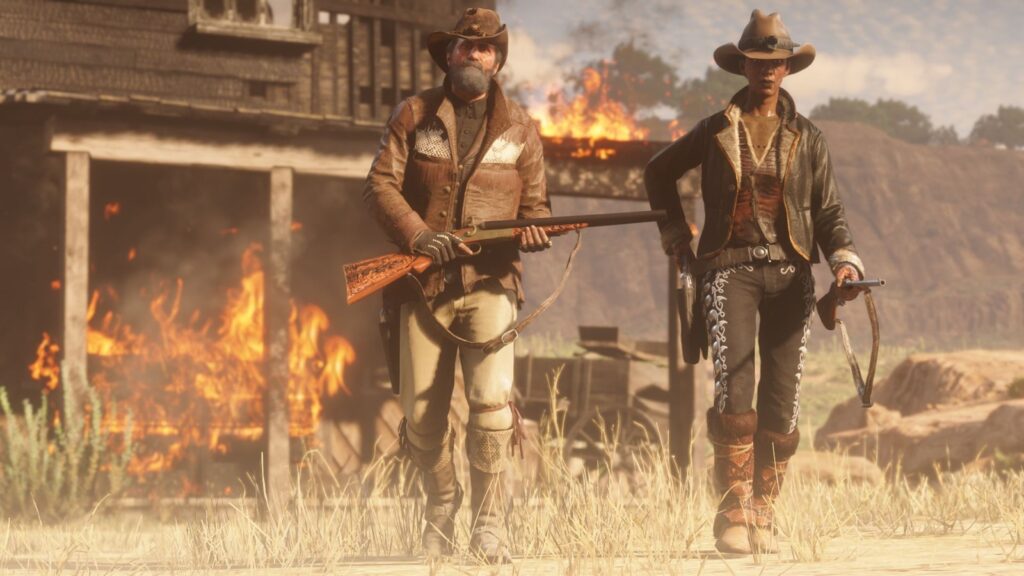
Sorry about the late post. It took me a lot longer to get through all the entries due to the fact that I not only had to read the loglines, but the first pages as well!
It made choosing contestants hard. There were some great loglines that had weak first pages. And there were some strong first pages that had weak loglines. I wasn’t sure which to give more weight to. In the end, I decided to split the difference. So you’ve got entries that have good loglines, you have entries that have good first pages, and hopefully a couple that have both. :)
For those who haven’t played the Scriptshadow Showdown game before, I’m giving you six contestants below. These were chosen from over 250 submissions. Your job is to look at all six and then vote for your favorite in the comments section. Whoever gets the most votes receives a review next Friday.
The deadline for voting is Monday at 11:59pm Pacific Time. The reason it’s Monday and not Sunday, like usual, is because in the U.S. we have a big holiday (Memorial Day) on Monday. So there will be no post that day. It’s all about the Short Story Showdown.
Okay, let’s check out our entries.
Good luck to all!
Title: Roadkills
Genre: Dark Urban Fantasy / Horror
Logline: After her son’s tragic death in a car crash, a grieving mother uncovers a chilling truth: shapeshifters stalk rural America’s interstates, morphing into beasts to engineer fatal accidents and devour the souls of the dying.

Title: Pitchforks
Genre: Thriller
Logline: When a soft-spoken church organist in rural Ohio reads an article about the emergence of a new technology that allows police to solve old crimes using something called “DNA,” he must return to an old crime scene to ensure a 12-year-old secret remains unearthed.

Title: The Empty Seat
Genre: Suspense
Logline: A recently demoted executive finds himself being harassed by a dangerous thug sitting next to him on the last bus back home to the suburbs.

Title: Mantrap
Genre: Adventure
Logline: An American tourist struggles to survive, caught in a trap while on safari in Africa.

Title: Closure
Genre: Crime/Supernatural
Logline: A grieving father seeks vengeance when a serial killer sends him a vial containing his daughter’s last breath.

Title: The Haunted House Game
Genre: Horror/Comedy
Logline: A 47-year-old, ex-convict, Pac-Man video game champion competes in a real-life version of the game involving cutthroat contestants, terrifying challenges, and deadly ghosts to win 10 million dollars that can pull him out of his misery.


Lean times at the box office!
Don’t worry. The good movies are coming.
But they sure are making us suffer in the meantime! A Planet of the Apes sequel? This is like making us eat at the school cafeteria when there’s an In and Out right across the street.
The latest entry in the Lame-O Summer 2024 Movie Olympics is Planet of the Apes Human Girl Says Hi or whatever it’s called. Even if I went to check the actual title of this film, I would forget it by the time I came back to this document. That’s how unoriginal these Apes sequels have become. Literally 98.123% of the movie is shots of apes in a forest. I don’t even know who this director is. When I heard “Wes Ball,” I said, “Wes Ball, the actor from American Beauty, is directing now?”
Because the studios are releasing these second banana movies, there’s nothing much to talk about. At least you used to be able to marvel at the motion-cap technology that brought these apes to life. Now the biggest talking point is that the Apes movies do sorta better overseas. Oooooh. Can’t wait to spend three hours at poker night debating that nugget.
All joking aside, there’s a reason I liked the initial movie in this franchise and why none of the others have made sense to me. The initial movie was simple and I could buy into it. Every other sequel has tried to convince us that a planet which has less than half a million apes, has been able to take over 8 billion humans. It doesn’t make sense on any level.
My whole thing is: If the core concept doesn’t make sense, your script won’t work. It will work enough that if you pour 150 million into it and another 100 million into advertising, it will trick enough people to see it that you can claim a 50 million dollar opening. But nobody cares about this franchise and I honestly believe it’s because the core of the concept doesn’t make sense.
Speaking of animals, my current obsession is Baby Reindeer. Not just the show but the circus surrounding the show. Fiona Harvey, the woman who the stalker character of Martha is based on, was on Piers Morgan over the weekend! She claims she left creator Richard Gadd a total of four voicemails, three e-mails, and a couple of texts. There’s a bit of discrepancy there as Gadd says it was closer to hundreds of voicemails, tens of thousands of e-mails, and an uncountable number of texts.
I have to admit Harvey seemed quite reserved in the interview. So either Gadd did exaggerate this whole thing or she was on a whole lot of meds.
Either way, it does bring up the question of, “How personal can you get in your writing?” I’ve always advocated for truth from screenwriters. It’s the #1 path to creating a strong original voice.
But there’s clearly a tax to being so truthful. Gadd, who was a nobody for a decade, experienced these events and built a story universe around them (first in his stand-up act, then in his play, now on a TV show). The latter has turned him into a mega-star overnight.
But you can tell when you watch interviews of Gadd how uncomfortable he is getting into the details of the real-life inspirations. He can feel Fiona breathing down his neck. She’s going to sue and who knows what’s going to come of that. But I can’t imagine it’s going to be enjoyable, even if everything he’s said is 100% accurate.
Moving onto lighter fare, Star Wars is about to sign Sigourney Weaver into its far far away galaxy. She’s going to play a substantial role in The Mandalorian and Grogu. Much like The Acolyte brought in Carrie-Anne Moss, it appears that Lucasfilm is all about stunt casting in an attempt to build as much goodwill back into its fractured fanbase as possible.

I know talking about Star Wars these days is the equivalent of kicking the nerd after he’s already been beaten up by the bully. The franchise doesn’t have any future shows or movies that the fanbase is excited about.
We can dog Marvel all we want. But Marvel still has Spider-Man. It still has Deadpool and Wolverine. It still has the new iteration of the X-Men to bring into the fold. There are things to get excited about with Marvel.
Trying to get excited about Star Wars these days is like trying to get excited about getting Amazon gift cards for Christmas. Sure, there’s value to them. But they’re not exactly… exciting. The Acolyte, by all behind-the-scenes accounts, is supposed to be lousy. We have an upcoming Rey movie, which is a tough sell considering the character became less interesting with each sequel. There’s James Mangold’s “First Jedi,” movie, which has a teensy bit of promise but so little is known about it that it’s hard to form an opinion either way. And then, of course, there’s Mandalorian and Grogu.
The problem with our buddy Mandor and his adorable little green partner-in-crime is that they’re building a movie around the franchise on a downslope. You never want to build a movie on a franchise that’s slipping. You want to build it on a franchise that’s rising.
The perfect time to release this film would’ve been after the first season, when everybody loved The Mandalorian. But most Star Wars fans I talk to barely remember what happened in Season 3. So you’re building a movie in an attempt to SAVE the franchise which is an inherently negative motivation.
There’s got to be a good Star Wars movie idea out there, right? There’s got to be something that would get people excited. Any ideas?
A couple other things that popped up over the weekend are, one, that JJ ABRAMS IS BACK! Nobody has seen the man since the premiere of Rise of Skywalker. As I mentioned before, I once had a contact inside Bad Robot (she no longer works there) and she told me that when Abrams went to the premiere, the movie had been changed since his final edit and nobody told him. So he was furious. I get the feeling that was the worst professional experience of Abrams’ life, which is probably why we haven’t heard from him. Still, 5 years is a long time to disappear for someone of Abrams’ stature.
He’s teaming up with my buddy Glen Powell. I say “buddy” because, of course, Powell was in the film, “Anything but You.” “Anything but You” also starred Sydney Sweeney. Sweeney and I are tight in that I was a fan of hers before everyone else. So, by association, Glen is my friend.
I have to say I like this team-up. Powell is making a movie, Twisters, that I thought couldn’t possibly work. But it looks cool. So maybe he is the next Tom Cruise like everybody is saying he’s going to be. We don’t know yet what the Abrams movie is about. But I’m just happy he’s back. He needs to work again!
Finally, they’ve announced more Lord of the Rings films, the new ones built around the character of Gollum. Good idea? Look, these studios are scared. And when they’re the most scared, they turn to the IP that made them the most money. They don’t care if it makes sense to add more films to the franchise. They just know it’s a better bet than going with something original. Cause original is the unknown. And the unknown is terrifying. That’s why IP is a blessing and a curse. With that said, I suspect these films will be better than the Amazon Rings series.
Oh, one more thing. Check out the interview Anna Halberg and Spenser Cohen did over on The Hollywood Reporter. Both these two have been huge supporters of Scriptshadow throughout the years. Anna was actually instrumental in getting Alex Felix’s Where Angels Die made (as “The Gateway”). They have a new horror movie out called, Tarot. :)
Have you been struggling with your dialogue? I have over (that’s right, OVER) 250 dialogue tips in my new book, “The Greatest Dialogue Book Ever Written.” You can head over to Amazon and buy the book, right now!
By the way, I still have one discounted script consultation available. 40% off. You want notes that are going to be a game-changer for your screenplay?! First person who e-mails me gets it! Carsonreeves1@gmail.com

Week 1 – Concept
Week 2 – Solidifying Your Concept
Week 3 – Building Your Characters
Week 4 – Outlining
Week 5 – The First 10 Pages
Week 6 – Inciting Incident
Week 7 – Turn Into 2nd Act
Week 8 – Fun and Games
Week 9 – Using Sequences to Tackle Your Second Act
Week 10 – The Midpoint
Week 11 – Chill Out or Ramp Up
Week 12 – Lead Up To the “Scene of Death”
Week 13 – Moment of Death
Week 14 – The Climax
Week 15 – The End!
Week 16 – Rewrite Prep 1
Writing is rewriting.
That’s what they tell us, anyway.
I think of writing more as problem-solving.
You write a script. You read it back. There are parts of it you don’t like. Now you gotta figure out how to fix those parts.
Usually, one of three things happens when you write a script.
The first is that you write something very close to what you imagined the script would be. This is the ideal situation and requires the least amount of rewriting.
The second is that the script becomes something different from what you imagined. You realize that this new direction is more interesting and your rewrites focus on detouring the script towards this new idea. The first draft of The Sixth Sense was about a kid who paints images from the future. It obviously became something much better than that.
The third is that your script becomes something different from what you imagined but you DON’T like this new version. This can happen because a script is a living breathing thing. It wants to take you where it wants to take you. So it’s very easy to lose control of it. In this case, your rewrites work to get the script back on track.
Regardless of which of these issues you run into, your job is to troubleshoot what the main problems are and then write up a plan to fix them. I’m partial to creating an outline for rewrites. I like the guidance that they give me. You can rewrite off memory and feel but, in these early stages, when you’re on your first or second draft, there are so many issues with the script that it’s advantageous to give yourself as detailed a fix-it-up guide as possible.
After last week, you should have identified the major problems in your script. When it comes to script problems, there is a hierarchy of the worst problems you can have. These are problems that, if they are present in your script, it’s going to be a loooong rewrite process. In some cases, it may be a rewrite you don’t want to do. These top things are…
Conceptual problem – This is the hardest script problem to fix in the business. If your concept is weak or isn’t working, the only way to fix it is to come up with another concept and rewrite the entire script. A good example of this is Megalopolis, the upcoming Francis Ford Coppola movie which I did a script review on years ago. The concept is so confused and nebulous that the story never knows what it is. Which is why everyone who’s seen the movie has hated it.
A boring main character – This is the guide who’s taking the reader through your story. So if we don’t like him, or don’t care about him, or don’t find him compelling in some way, it doesn’t matter if you have a great concept and a great plot. We won’t care. And the thing with character problems is that they’re very hard to fix. Because characters are based on people and people are complex. So there is no perfect recipe to create a character people love. Believe me, Hollywood has tried. I’ve helped writers through rewrites where we’ve tried 10 different versions of a character that wasn’t working and none of them fixed the character. So this one is, indeed, a toughie.
Weak structure – The main thing that good structure provides is an ENGINE underneath every section of the story so that the story always has pace. The second your structure weakens, the reader will find it difficult to stay interested. They won’t feel like there’s a reason to keep reading. This happened with a script I consulted on not long ago where the story’s major question was resolved at the end of the second act. So then why do we need to keep reading the third act?
If you’re dealing with any of these things, it’s going to be a tough rewrite. But, as long as you know what the problem is, you can start putting effort towards solving it.
To give you an idea of some other problems you may encounter, here is a list of script problems from consultations I did this year…
- A weak villain.
- A major character who doesn’t tonally match the rest of the screenplay (all the other characters are operating in a drama while this character is operating in a thriller).
- The writer makes the path way too easy for their main character, giving them no major obstacles to overcome. This results in very little drama.
- Little-to-no setup. We’re thrust into the story before we know or care about any of the characters.
- (Specific Example) Two characters know each other well. Years later, one of them is going to try and con the other. He gets plastic surgery so he doesn’t look like his former self. They then spend hours upon hours together for the con and, somehow, the mark never suspects that this is his old friend he used to know.
- Script lacks detail and specificity in both the world and the characters, leaving the story feeling thin and surface-level.
- Doesn’t exploit the uniqueness of the concept enough.
- Major moments lack authenticity. They all feel artificially manufactured rather than something that would happen in real life.
- Script covers way too many characters and subplots, leaving no time for the plot to move forward, resulting in a slow stale narrative.
- Script follows only two characters on a repetitive journey, so we get restless quickly.
As you can see, there are tons of issues that can pop up in a screenplay. I can’t go over every major one and tell you how to fix it. That would make this a 250,000 word post. But I can take you through the big three.
Conceptual problem – You usually can’t fix this. Which is why I tell writers to get logline consultations from me BEFORE THEY WRITE THEIR SCRIPTS (Just $25 – e-mail me at carsonreeves1@gmail.com if you want one) so I can save them a lot of time. A conceptual problem is a page 1 rewrite so just make sure that if you *do* adjust your concept that, THIS TIME, you get confirmation from other people you trust that it’s a good movie idea. I’ve watched writers spend, literally half-a-decade trying to make a script work that will never work due to its weak concept.
Boring main character – The most common reasons for a boring main character are that they are PASSIVE and they have LITTLE-TO-NO PERSONALITY. So start by making them more active. And then give them some personality. Make them funnier, more intelligent, more eccentric, more polarizing, more conflicted, stranger. Too many writers overlook personality when it comes to their protagonists. Don’t be one of them. But honestly? Audiences LOVE active characters. So just making your character more active can accomplish a LOT.
Weak structure – Make sure your major beats are happening where they should. In a 120 page screenplay, the inciting incident happens on page 15. The first act break at 30. The midpoint at 60. The second act break on page 90. From there, make sure there is always a GOAL, PROBLEM, MYSTERY, or COMPELLING UNRESOLVED ISSUE driving each section of the screenplay. So, for example, if you’re bored reading your script on page 50, ask yourself, “Do my characters have a goal in this section? Or is there a mystery they want the answer for?” Or is there a problem that needs to be resolved? These are the things that create an engine underneath the story. If there are no goals, no mysteries, no problems, no unresolved issues… of course that section of your script is going to be boring.
So, your homework for this week is to write out your plan of attack for your rewrite. You can do this in a couple of ways. For those of you who hate outlining, just write up the 3-5 biggest problems in your script so that you can see those problems with your own eyes. If you want to write quick solutions to them, that’s fine as well. This “lazy man’s” outline approach can be confined to a single page.
For the rest of you, I would try to write up a detailed outline for how you’re going to fix this thing. You can divide this up however how you want. For example, you can say, “Pages 1-15” and then write out what you’re going to do inside those pages to address the problems. Or you can get really detailed and break it down by individual scene. Then write out what you need to do in that scene that will address the script issues that you have.
Here’s a snippet from an old novel outline I wrote up (a missing girl narrative). It’s not going to make sense but you can see how detailed I get. The different color text is to visually keep track of a subplot. When you write a novel, you’re dealing with 100,000 plus words so it’s infinitely harder to track everything. You should be happy you only have to manage 20,000 words!

The more you have written down, the more ready you’re going to be for the rewrite. Cause next week, we start writing again. So this is your last chance to get all your thoughts together. And, by the way, the Mega Showdown where you’ll be able to enter this script is going to be on July 25th. So we’re going to be moving through this rewrite pretty quickly.
All right, get to work! Oh, and please share your own tips and tricks for rewriting in the comments!

